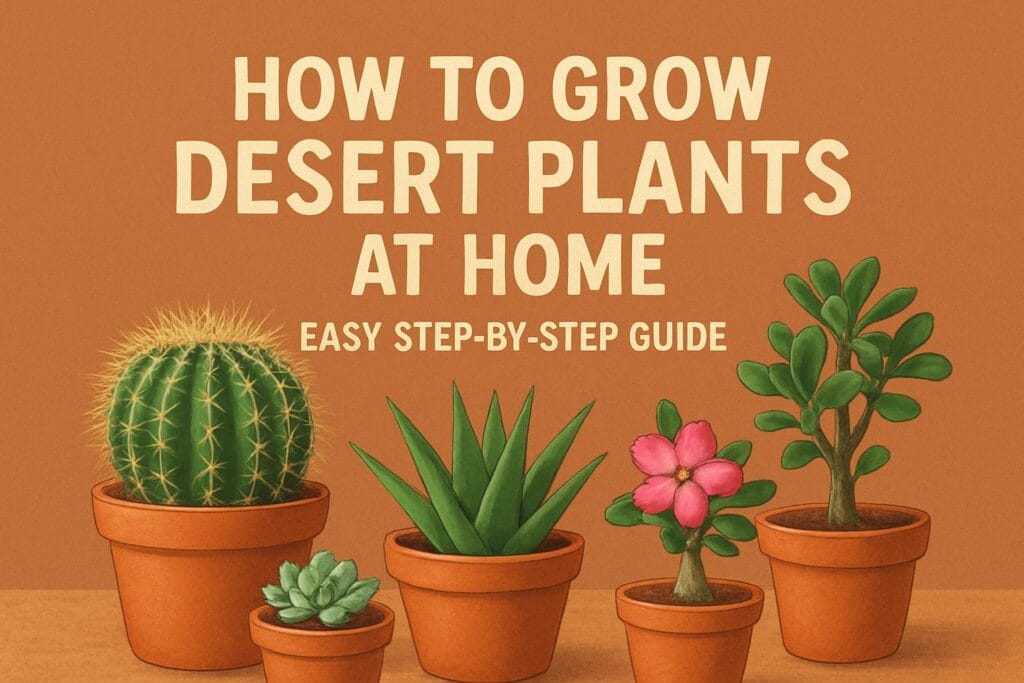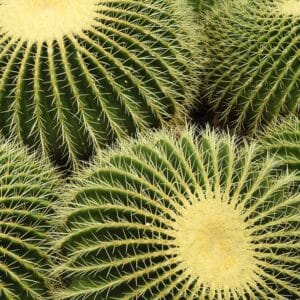Among the most amazing creatures on the planet are desert plants. They adapt in amazing ways to survive, even though they thrive in hostile arid and sun-burned environments. Desert plants demonstrate that resilience and beauty can coexist from succulents that retain water in their fleshy leaves to cacti with thick, spiky stems.
There’s no doubt that you can grow desert plants at home if you’ve ever been impressed by them. In reality, desert plants are excellent options for both indoor and outdoor gardens and are also very low-maintenance. They add a special charm to any living area use little water and grow well in containers.
In this comprehensive guide we’ll walk you through easy step-by-step methods to successfully grow desert plants at home whether you live in a city apartment a suburban house or anywhere in between.
Why Grow Desert Plants at Home?
Before jumping into the step-by-step guide, let’s explore why desert plants are worth having in your home garden.
Unlike tropical plants that demand frequent watering and high humidity desert plants thrive on neglect. A little sunlight and occasional watering are usually enough.
Air Purification
Some desert plants like aloe ver, not only look beautiful but also purify indoor air and release oxygen, improving your living environment.
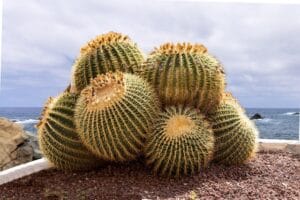
Health Benefits
Aloe vera, prickly pear cactus, and agave are well-known for their medicinal and nutritional properties. Having them at home means easy access to natural remedies.
Aesthetic Appeal
Desert plants have striking shapes textures and colors that add a modern, minimalist vibe to any décor.
Eco-Friendly Gardening
Growing desert plants means conserving water, which is an environmentally friendly gardening practice.
How to Grow Desert Plants at Home
Now that you know the benefits, let’s dive into the process.
Choose the Right Desert Plant
Not all desert plants are the same. Some are better suited for indoor spaces, while others thrive outdoors. Here are popular options:
- Cacti —Famous for their spines and unique shapes.
- Succulents—known for their fleshy water-storing leaves.
- Flowering Desert Plants– Add vibrant colors to your home garden.
Beginners often start with succulents or small cacti because they are hardy and forgiving.
Select the Right Pot or Container
Desert plants need excellent drainage to prevent root rot. Choose:
- Pots with drainage holes.
- Terracotta or clay pots (they absorb excess moisture).
- Shallow containers for succulents.
Avoid plastic pots as they trap water and can cause overwatering issues.
Use the Perfect Soil Mix
Desert plants hate soggy soil. The right soil should drain quickly while retaining minimal moisture. You can either buy cactus/succulent soil mix or make your own by combining
- 2 parts sand or perlite
- 1 part potting soil
- 1 part small gravel or pumice
This mix mimics desert conditions and keeps roots healthy.
Provide Adequate Sunlight
Sunlight is crucial for desert plants. Place your plants where they get:
- Indoors: At least 4–6 hours of direct sunlight near a south or west facing window.
- Outdoors: A bright sunny location with partial shade in extremely hot climates.
If you don’t have enough natural sunlight indoors, consider using a grow light.
Watering Desert Plants Correctly
This is where most beginners make mistakes. Desert plants need less water than typical houseplants.
- Rule of thumb: Water only when the soil is completely dry.
- In summer: Water once every 7–14 days.
- In winter: Water once every 3–4 weeks.
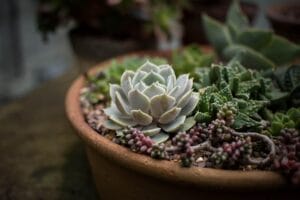
Always water deeply allowing excess water to drain out. Never let the pot sit in water.
Maintain Proper Temperature & Humidity
Desert plants love warm dry environments.
- Ideal temperature: 60–80°F (15–27°C).
- Keep away from cold drafts or air conditioners.
- Humidity should stay low (avoid bathrooms or overly humid rooms).
Fertilize Occasionally
While desert plants don’t need much fertilizer feeding them during the growing season helps them thrive.
- Use a diluted cactus or succulent fertilizer once a month.
- Avoid fertilizing in fall and winter when growth slows down.
Pruning and Repotting
- Pruning: Remove dead leaves flowers or damaged stems to encourage new growth.
- Repotting: Every 2–3 years, move your plant into a slightly larger pot with fresh soil. This prevents overcrowding and nutrient depletion.
Protect from Pests
Even hardy desert plants can attract pests like mealybugs spider mites and scale insects.
- Check plants regularly.
- Use neem oil or insecticidal soap for natural pest control.
- Avoid overwatering, as pests thrive in damp conditions.
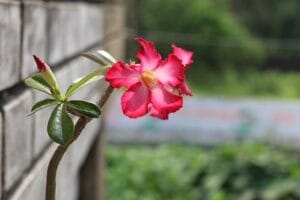
Propagation for More Plants
One of the best things about desert plants is how easily they multiply.
- Succulents: Simply cut a leaf, let it dry for a day, and plant it in soil.
- Cacti: Break off a small pad, allow it to callus and plant it in sandy soil.
- Aloe Vera: Remove pups or baby plants from the mother plant and repot them.
This way, you can grow an entire collection from just one plant.
Best Desert Plants for Beginners
Here’s a quick list of beginner-friendly desert plants:
- Aloe Vera– Healing plant, low maintenance.
- Jade Plant – Symbol of luck and prosperity.
- Echeveria- a beautiful rosette-shaped succulent.
- Golden Barrel Cactus – Eye-catching round cactus.
- Desert Rose (Adenium) — Gorgeous flowers and easy to care for.
Common Mistakes to Avoid
- Overwatering – the killer of desert plants.
- Wrong soil type – Regular potting soil retains too much moisture.
- Too little sunlight – leads to weak, leggy plants.
- Ignoring pests – small infestations can spread quickly.
Decorating with Desert Plants
Desert plants are not just easy to grow; they are also stunning décor elements. Here are creative ways to use them at home:
- Succulent Terrariums – Perfect for coffee tables and office desks.
- Cactus Windowsill Garden – Adds a touch of desert charm indoors.
- Vertical Succulent Wall – A modern, living piece of art.
- Outdoor Rock Garden – Combine desert plants with stones for a natural desert landscape.
Final Thoughts
Learning how to grow desert plants at home is rewarding easy and perfect for both beginners and experienced gardeners. With just the right pot soil light, and watering schedule, you’ll enjoy thriving plants that not only beautify your home but also bring health charm and a little piece of the desert into your life.
So, whether you choose aloe vera for its healing properties, jade plants for their symbolism, or cacti for their unique appearance, desert plants are sure to brighten your space.
Start small, follow these easy steps, and soon you’ll have a thriving indoor desert garden!

